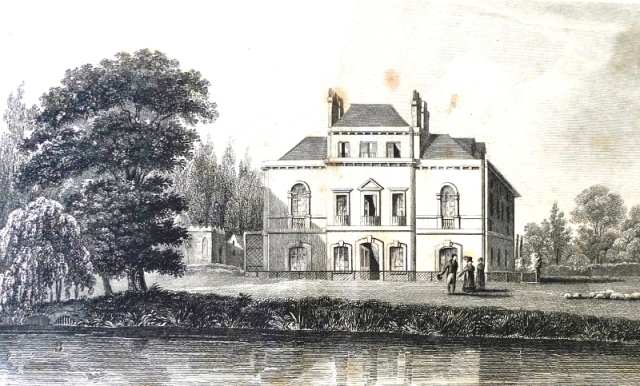A reader of a previous blog on Queen Caroline asked if the demolition of Brandenburg House so soon after her death had anything to do with the King: the fact that King George so disliked his wife and that she had lived at the house on her return to London. This does not seem to be the case.

Brandenburg House
Certainly the Queen lived there for the last two years of her life and died there in August 1821. The Queen’s funeral procession on 14 August 1821 which was overseen by the Prime Minister, Lord Liverpool, started at Brandenburg House and ended at Harwich where the hearse was taken by ship to Germany. The cortège departed at precisely 7.30am. The weather was ominous, the heavens opened and it poured with rain, soaking the escorting guards, a squadron of Oxford Blues in their dress uniforms, to the skin.

Queen Caroline funeral procession
Brandenburg House belonged to the Margravine of Brandenburg and was only lent to Queen Caroline for a couple of years. After the Queen died the Margravine was living in Naples and evidently had no intention of returning. It was she who ordered the sale of the property the next year.

The Margravine of Brandenburg
Faulkner is the source of much of what we know about Fulham and Hammersmith in the early years. The Margravine died in January 1828 but she had previously written her memoirs. In History and Antiquities of the Parish of Hammersmith (1839), Faulkner quotes from these memoirs. She wrote of the sale of the contents and the demolition of the house:
“It is now completely levelled to the ground, the dry rot having got into its timbers, and as I never intended again to reside there, after I had been so long in Italy, I disposed of a portion of the land that surrounded it, and by the sale, which proved highly advantageous, with my accustomed good fortune, I was considerably benefitted. I think what was sold produced more than 3 times the sum which was given for it”.
The Queen would have brought with her a lot of furnishings and furniture and these were removed to her town house after her death and sold on 20 February 1822 and the following 6 days. However a sale took place at Brandenburg House on 9 February 1822 of “magnificent, furniture, china and books”. There was perhaps a certain assumption by the public that these goods had also belonged to the Queen and that could explain why the Margravine did so particularly well from the sale and received rather more than she might have expected.
The pictures and furnishings were disposed of in February 1822 and then in May the building materials (the staircases, fire places, the flooring etc) were sold. In the course of the next 12 months the house was “razed to the ground”.
A copy of the catalogue is kept in the H&F Archives (apologies for the rather poor photograph).

Sales catalogue
And here is an example of a page chosen at random. You can see how everything was for sale, even the window sills and the partitions in the attic.

Page of catalogue
In less than a twelvemonth after the death of Queen Caroline, the materials of Brandenburgh House had been sold by auction, and the mansion pulled down. Faulkner had described the house in 1812 as in the “finest condition” yet in October 1822, he could write that there was:
“not a vestige remaining to attest its former grandeur and magnificence; every stone has disappeared; the very foundations have been taken up, and grass now covers the site”
(The Gentleman’s Magazine, October 1922)
The Haig Distillery was erected in 1857 on part of the former grounds and the final section of the grounds was sold in the early 1870s. When it was announced that this land was on the market, The Times wrote:
“A host of memories rise to the mind at the announcement that the Brandenburgh estate is on the market “for building purposes”. It is sincerely to be trusted that the site will not be in the course of the next few months be covered with lines of tenements of the class that has so far disfigured the neighbouring Salisbury estate and banished forever the pleasant rural character of a corner of the metropolis much in vogue with society till a generation or so ago.”
In fact it was sold for industrial use to the Manbre Saccharine Company and the Manbre Sugar Refinery was built on the Brandenburg Farm Estate, a little downstream from the site of the house, in 1876.
by Fiona Fowler,
Hammersmith and Fulham Local History and Archives volunteer
You must be logged in to post a comment.